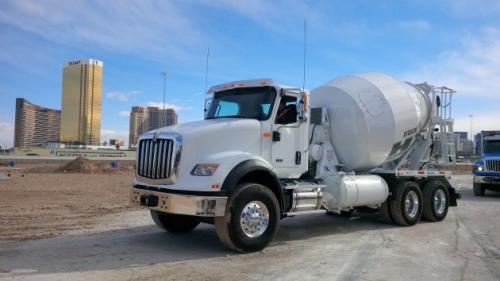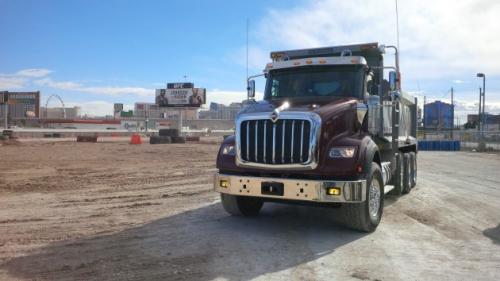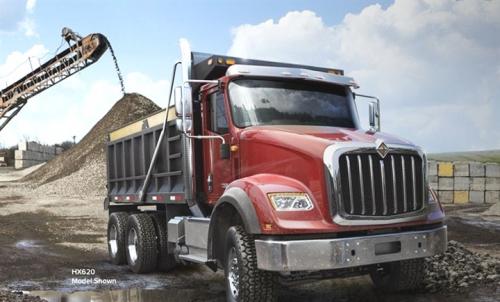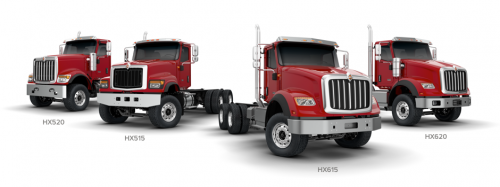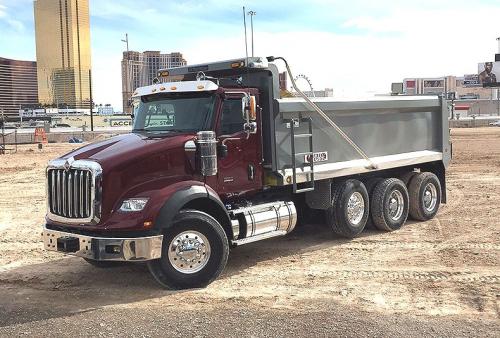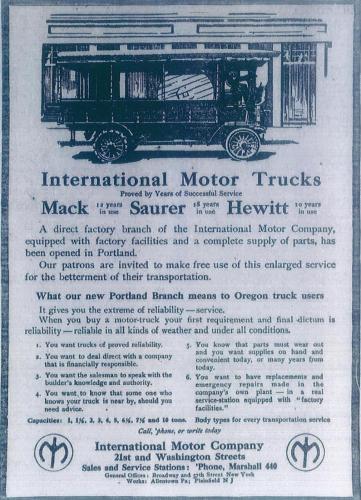
kscarbel2
Moderator-
Posts
18,895 -
Joined
-
Days Won
114
Content Type
Profiles
Forums
Gallery
Events
Blogs
BMT Wiki
Collections
Store
Everything posted by kscarbel2
-
Trailer/Body Builders / February 1, 2016 Volvo’s U.S. retail market share was a record 12.4 percent in 2015, 0.4 percentage points higher than in 2014, with a retail volume of 30,930 vehicles compared with 26,555 in 2014. Volvo also posted a record in Canada, where market share climbed 1.0 percentage point to 16.3 percent (4,884 vehicles) compared with 2014 (4,510). Volvo also achieved a record 12.2 percent NAFTA market share (36,940 vehicles), compared with 11.9 percent (32,281) in 2014. Volvo market share in Mexico was 4.9 percent. Volvo attributed its record-breaking 2015 to positive customer response to its fuel-efficient vehicles and powertrain and its best-in-class Uptime support. The strong performance also resulted in the production of more trucks than ever before at its New River Valley Assembly plant, based in Dublin, Virginia, where all Volvo models for North America are assembled. “We are very proud of our people, whose dedication allowed us to make these great achievements,” said Gӧran Nyberg, president of Volvo Trucks North America. “It’s clear from our strong performance that the market continues to see the fuel efficiency benefits offered by our powertrain and aerodynamic truck design, combined with our commitment to maximizing Uptime for customers. While we are very pleased with our 2015 results, we will continue to seek opportunities to make advancements in products, service and support that positively impact the bottom line of our customers.” Volvo engines were spec’d in a record 93 percent of the trucks sold in 2015, and Volvo I-Shift penetration was a record 83 percent. More than 27 percent of all trucks sold in 2015 featured an XE package. The XE package, offered for Volvo’s 11-liter D11, 13-liter D13 and 16-liter D16 engines, improves fuel efficiency by lowering engine rpm at a given vehicle speed, a concept Volvo calls “downspeeding.” Made possible through the combination of I-Shift and a Volvo engine with modified software, XE allows the engine to cruise about 200 rpm less than the average truck sold today. Volvo’s focus on Uptime also was a key driver of the strong performance. Volvo’s North Uptime Center, based near its North American headquarters in Greensboro, N.C., brings together key support employees and technology under one roof to help ensure that customers’ trucks keep moving. The Uptime Center serves as the home for Volvo Action Service (VAS) staff, Volvo’s 24/7 support experts, who receive alerts via Remote Diagnostics when monitored fault codes appear. Remote Diagnostics is Volvo’s telematics-based proactive diagnostic and repair planning system that monitors critical fault codes. When an issue is detected, the system identifies what parts will be needed and provides technicians with straightforward repair instructions – even before the truck arrives for service. Remote Diagnostics can reduce the diagnostic time by up to 70 percent and lower repair time by more than 20 percent. Nearly 100,000 Volvo trucks are equipped with the system, which has been standard on all Volvo-powered models since 2013. Volvo Press Release - http://www.volvogroup.com/group/global/en-gb/volvo%20group/worldwide/volvo-group-north-america/_layouts/CWP.Internet.VolvoCom/NewsItem.aspx?News.ItemId=151465&News.Language=en-gb
-
International Truck Launches “HX” Vocational Series
kscarbel2 replied to kscarbel2's topic in Trucking News
International debuts HX Series vocational trucks Truck News / February 1, 2016 International PayStar replaced with more modern, higher-end HX Series With a Vegas-worthy production, International Trucks today showed for the first time its new HX Series vocational trucks. The reveal came in advance of World of Concrete and starred a truck that Bill Kozek, president, truck and parts with Navistar, said will return International to the front of the pack in the vocational truck segment. “The HX will be a catalyst for International to regain leadership in the premium vocational market segment where we historically had lead,” Kozek said. “When I came here, one of the first discussions was about how we needed a vehicle like the HX to compete and to win in the construction, heavy-haul and mixer segments again. Today, we see the results of several years of hard work come to life.” The HX represents International’s first new model since 2010 when it introduced the TerraStar Class 4/5 truck. Four HX Series models will be available: the HX515, a 115-inch BBC set-forward axle straight truck; a HX615, a 115-inch BBC set-back axle truck or tractor; the HX620, a 120-inch BBC set-forward axle truck or tractor; and a fourth model, the HX520, which will debut at Truck World in Toronto in April. The HX520 will be a 120-inch BBC set-forward truck or tractor intended for heavy applications and the likely best-seller among HX models in Canada, which is why International chose to launch it there. The 515 and 615 will be powered by Navistar’s N13 engine while the HX520 and HX620 will get Cummins ISX15 power. The front end of the new truck is curvier than the PayStar it replaces, and it also boasts a more stylish interior. And it was introduced to customers and dealers in style, too. A newscast cut into the presentation on large TV monitors to break the story of an International truck that had been commandeered by a fleeing Elvis impersonator who had robbed a local casino. A police chase ensued, and ended in a yard within sight of the Strip, where customers and dealers were gathered. After some stunt driving at the launch site, Elvis was arrested by a heroic cop, who turned out to be none other than Denny Mooney, Navistar’s senior vice-president, global product development. Only in Vegas. “Of course we couldn’t pass up introducing our new truck in an over the top way,” Mooney said. “It’s Vegas – they wrote the book on being over the top.” Three HX trucks were presented for ride-and-drive opportunities. A lap around the short makeshift off-road course revealed a truck that rides well, turns tight and features a high-end, comfortable interior. “At its core, the HX represents the ultimate in endurance; a truck designed to tackle the most punishing loads and to run long and run hard and to keep the operator comfortable when he’s doing his job,” Mooney explained. International said the truck was designed around four principle attributes: strength and durability; driver productivity; style; and uptime. The HX Series can trace its roots to a former joint venture between Navistar and Caterpillar. Signs of that former partnership are most prominent in the interior. Soft-to-the-touch surface areas, snappy, solid rocker switches and a center console that angles toward the driver and provides easy access to controls are among the similarities. Outside, the truck features stylish halogen headlights with a distinctive LED brow. The hood slopes and tapers in to provide greater forward visibility than the PayStar. A raised sightline down the centre of the hood helps drivers orient themselves. Mooney said the HX offers the best forward visibility in the segment as well as a larger rear window for rearward visibility. The wheels cut 40 degrees for a tight turning radius. The truck was also built to be lighter. A three-piece Metton hood is lighter than fiberglass, the cab is aluminum and the 12.5-inch frame rails offer all the strength of double 10-inch frames, but at less overall weight, International claims. The truck also boasts the industry’s strongest tow pin, rated at 150,000 lbs for extreme recoveries. The truck I drove had classic-styled external air cleaners, an option on the longer BBC models. Mooney said designers were challenged to beat the truck up during the product validation process. “As part of the product development process and validation testing, the HX series was tested extensively in our labs in Melrose Park, Ill. and our new proving grounds in Indiana,” Mooney said. “We ran accelerated life testing on the shaker – this simulates 10 years of wear and tear of a severe-service truck in extremely difficult duty cycles. We also put it through the most rigorous portions of our proving grounds. The bottom line is, I told our test engineering team to take this truck and punish it. I wanted them to try to break it – after all, we know how our customers use these trucks. When things broke, we redesigned them so they didn’t break and when things came loose, we found ways to make them stronger.” Nice touches such as LED lighting inside the cab, a tilting, telescoping steering column, air-conditioning, power locks and power windows are all standard. The smooth ride is attributed in part to a new DriverFirst cab air suspension with 52-inch springs. Jeff Sass, senior vice-president with Navistar, said International bucked the trend towards vertical integration, opting instead for an approach he dubbed as “open integration.” “This is where we work seamlessly with leading component manufacturers and integrate leading technologies into our trucks,” he said. The launch of the HX seems to have given International Trucks back some of its swagger. “It has been a few years since we were able to say we had the product able to compete and win in the severe-service market,” Sass said. “With the HX Series, we are now able to complete our offerings in the construction and concrete markets. This will now give International Truck the most comprehensive severe-service lineup in the industry.” Sass said 132 HX trucks have already been ordered, even though the truck has just now been shown to the public. Kozek said the launch represents a great step forward in International’s resurgence. “As I reflect on where we are today, I’m incredibly proud of where we are as a company,” he said. “Today we’re building the best trucks we’ve ever built; our quality metrics show it and more importantly, our customers recognize it and believe it.” . -
American Honda Motor Co. Press Release / February 1, 2016 Photo gallery - http://www.caranddriver.com/photo-gallery/honda-ridgeline-super-bowl-50-ad-lifes-a-treat-video#1
-
International Truck Launches “HX” Vocational Series
kscarbel2 replied to kscarbel2's topic in Trucking News
The 12.4-liter N13 is the MAN D26 (D2676) built under license in Huntsville, Alabama. Since revising it from a "massive EGR" design to SCR, they renamed it N13. Navistar apparently discontinued production of the 10.5-liter MAN D20 (D2066). With the N10 up to 350hp, and the N13 now starting from 365hp (up to 475hp), Navistar reduced their annual licensee costs to MAN. The MAN engines are extremely good, proven the world over. Navistar engine portfolio - http://www.internationaltrucks.com/trucks/engines/ N9 & N10 Spec card - http://psndealer.com/dealersite/images/tricotruck/n9_n10_speccard.pdf N13 Spec card - http://www.internationaltrucks.com/vgn-ext-templating/itrucks/assets/pdf/N13_SpecCard.pdf -
International Truck Launches “HX” Vocational Series
kscarbel2 replied to kscarbel2's topic in Trucking News
Unlike the Tonka-inspired styling of the Kenworth T880 and T470, and Peterbilt 567 and 348, with the cheap new shared cab (purposed to restore Paccar's margins), the HX615 and HX620 are actually good looking construction trucks. And, the HX515 is considerably more attractive than its cousin, the CAT CT681. I'm forced to mention, the Peterbilt 367 is the last traditionally designed vocational truck on the market, and it's a looker. -
International Truck Launches “HX” Vocational Series
kscarbel2 replied to kscarbel2's topic in Trucking News
International Announces HX Vocational Series Heavy Duty Trucking / February 1, 2016 International Truck Monday launched its HX Series, a line of Class 8 vocational trucks and tractors designed for the severe service industry. It’s the first new vehicle introduced by International since 2010, executives said. The HX, for Heavy eXtreme, includes four models, with set-forward and setback steer axles and long and medium-length hoods. HX replaces the PayStar, on which it’s based. “The launch of the HX Series is an opportunity for International to recapture a leading position in the vocational market – a segment we previously led,” said Troy Clarke, president and CEO of Navistar. The new series is being unveiled at 1 p.m. Pacific Time Monday at the World of Concrete show in Las Vegas. The show formally opens Tuesday. International is taking orders for this vehicle immediately. The first vehicles will be delivered this spring. The four models include: - HX515, a 115-inch bumper-to-back of cab straight truck with a set-forward steer axle. Its primary vocations including concrete mixer, construction dump, refuse/roll-off and crane carrier. - HX615, also with a 115-inch BBC, with a set-back steer axle, available as a truck and tractor. It will serve similar vocations plus construction dump and platform. - HX520, is a 120" BBC Set-forward Axle Truck or Tractor with primary vocations including heavy haul tractor, construction dump and platform stake/crane. - HX620, with a 120-inch BBC and set-back axle, also available as a truck or tractor. It can be built as a heavy haul tractor, construction dump, platform stake, crane carrier. The HX515 and the HX615 models are powered by Navistar N13 diesels, while the HX520 and HX620 models get the Cummins ISX15. Executives said all models were designed for maximum strength and durability, driver productivity, bold styling and superior uptime. “The HX Series combines aggressive styling, unstoppable capability and driver-centric features to appeal to vocational truck owners in a whole new way,” said Denny Mooney, senior vice president, Navistar global product development, saying it was designed with the driver in mind. A sloped hood gives excellent forward visibility, he said, while a 40-degree front wheel cut makes for good maneuverability. The frame is huck-bolted together, and available 12.5- by 0.5-inch main rails are rated at 3.5 million resistance-bending moment at 13% less weight than a 10-inch-high rail, allowing room for a heavier load. “The design of our new HX Series is based on in-depth discussions with leading users of severe service applications,” said Bill Kozek, president, truck and parts, for Navistar. “Each of the four models in the series has been engineered to deliver unmatched performance for the most punishing jobs, while making operators more productive.” The HX series underwent rigorous testing at Navistar’s proving grounds in northern Indiana. HXs are now available for ordering and first models will be delivered in April. International dealers have more information, which is also available here. . -
International Truck Launches “HX” Vocational Series
kscarbel2 replied to kscarbel2's topic in Trucking News
Navistar launches new HX Series Fleet Owner / February 1, 2016 Aims to “recapture” Class 8 vocational market share The International HX Series is a new line of Class 8 vocational trucks being introduced by Navistar at the World of Concrete show in Las Vegas this week – a truck that will replace is PayStar model and that represents the first “all-new” vehicle introduced by the International Truck division of Navistar since 2010, said Troy Clarke, Navistar’s president and CEO, in a statement. “The launch of the HX Series is an opportunity for International to recapture a leading position in the vocational market – a segment we previously led,” he explained. “The launch of the HX Series underscores our commitment to innovation, our dedication to uptime and our position as a leader within the industry.” “The design of our new HX Series is based on in-depth discussions with leading users of severe service applications,” added Bill Kozek, Navistar’s president of truck and parts. Four HX Series models will be offered, with both set-forward and set-back front axle models in either short or long hood, depending on the application. Three models were unveiled at World of Concrete: - The HX515 is a 115in. bumper to back of cab (BBC) set-forward axle straight truck with primary vocations including concrete mixer, construction dump, refuse/roll-off and crane. - The HX615 is a 115-in. BBC set-back axle truck or tractor with primary vocations including construction dump, concrete mixer, platform stake/crane and refuse/roll-off. - The HX620 is a 120-in. BBC set-forward axle truck or tractor with primary vocations including heavy haul tractor, construction dump and platform stake/crane. - The fourth model, the HX520, is a 120-in. BBC set-forward axle truck or tractor with primary vocations including heavy haul tractor, construction dump and platform stake/crane. It will be formally unveiled at Truck World in Toronto in April. The HX515 and the HX615 models are powered by Navistar N13 engines, while the HX520 and HX620 models offer the Cummins ISX15 engine, Navistar said. The company added that it’s taking orders for the new HX line immediately, with the first vehicles expected to be delivered this spring. Photo gallery - http://fleetowner.com/equipment/international-hx-series-gets-vegas-sendoff#slide-3-field_images-182731 -
Navistar Press Release / February 1, 2016 New Class 8 Vocational Truck Models Drive International Truck's Re-Entry to the Construction and Concrete Market, Complete Severe Service Line-up International Truck today launched the International HX Series, a new line of Class 8 premium vocational trucks designed to deliver the strength and endurance required for the severe service industry. This is the first all-new vehicle introduced by International Truck since 2010. "The launch of the HX Series is an opportunity for International to recapture a leading position in the vocational market – a segment we previously led," said Troy Clarke, President and CEO, Navistar, Inc. "The launch of the HX Series underscores our commitment to innovation, our dedication to uptime and our position as a leader within the industry." The new truck series, unveiled today at the World of Concrete trade show, will replace the International PayStar model. "The design of our new HX Series is based on in-depth discussions with leading users of severe service applications," said Bill Kozek, president, Truck and Parts, Navistar, Inc. "Each of the four models in the series has been engineered to deliver unmatched performance for the most punishing jobs, while making operators more productive." International is taking orders for this vehicle immediately. The first vehicles will be delivered this spring. HX Series Addresses Full Range of Applications Four HX Series models will be offered, with both set-forward and set-back front axle models in either short or long hood, depending on the application. Three models were unveiled at World of Concrete: - The HX515 is a 115" BBC Set-forward Axle Straight Truck with primary vocations including concrete mixer, construction dump, refuse/roll-off and crane. - The HX615 is a 115" BBC Set-back Axle Truck or Tractor with primary vocations including construction dump, concrete mixer, platform stake/crane and refuse/roll-off. - The HX620 is a 120" BBC Set-forward Axle Truck or Tractor with primary vocations including heavy haul tractor, construction dump and platform stake/crane. The fourth model, the HX520, is a 120" BBC Set-forward Axle Truck or Tractor with primary vocations including heavy haul tractor, construction dump and platform stake/crane. It will be formally unveiled at Truck World in Toronto in April. The HX515 and the HX615 models are powered by Navistar N13 engines, while the HX520 and HX620 models offer the Cummins ISX15 engine. Each model in the HX Series delivers on four key principles of design: maximum strength and durability, driver productivity, bold styling and superior uptime. "The HX Series combines aggressive styling, unstoppable capability and driver-centric features to appeal to vocational truck owners in a whole new way," said Denny Mooney, senior vice president, Global Product Development, Navistar, Inc. "All you need to do is get behind the wheel of this truck and you will see that this is a major step forward in design, all with the driver in mind." Specifics of the HX Series include: Strength and Durability - Each model has a huck-bolted frame and cross members, which produce superior clamping force to minimize vibration and maximize structural integrity. - An available industry-leading 12.5" x .5" single rail delivers 3.5 million RBM at 13% less weight than a 10" rail, allowing room for a heavier load. - The industry's only dedicated vocational aluminum cab offers better durability than steel. - The three-piece Metton hood is stronger and lighter than fiberglass and is designed to resist cracking. - Doors feature stainless steel piano hinges for superior strength. - The industry's strongest tow pin is rated at 150,000 PSI for extreme recovery towing. Driver Productivity - The maneuverability and visibility of each truck in the HX Series is best-in-class. - A 40-degree wheel cut on both right and left turns allows for improved maneuverability, while angled fenders provide greater wheel clearance to help power through challenging grounds. - The hood's low angle makes for the industry's best front forward visibility, and the larger rear window compared to the company's prior model allows for superior rear visibility. - The HX Series is equipped with the all-new DriverFirst™ Cab Air Suspension, designed with 52" springs to produce a supremely comfortable and quiet ride reducing driver stress and improving productivity. - For faster and more convenient access, the HX Series hood has an assist mechanism requiring little effort to open. Bold and Aggressive Styling - Hoods and grilles across the entire lineup are designed to look great and stand out on the road and at the worksite. - Customers will have options for bright finishes. - The interior was ergonomically designed to offer more room for driver comfort and productivity. - The contoured door handles add hip room and storage space. - The central console is angled for easy reach to controls. - There is easy access to cup holders and the overhead console. - The standard tilt/telescoping steering column adjusts to accommodate any size driver. - Gauges are designed and positioned to deliver optimal visibility and vital information at a glance. - LED lighting is standard throughout, as are air conditioning, power windows and power locks. Industry-leading Uptime - Consistent with the International mission, the HX Series has been tested and validated to provide industry-leading uptime, with the sort of durability and endurance that customers demand. - At the Navistar Proving Grounds in Indiana, the HX Series was subjected to accelerated life testing, which simulates 10 years of wear and tear and vibration in extreme duty cycles. - Vehicles underwent staggered bumps testing, which generated torsional twist in the chassis, to ensure suspension components were stabilized and equalized. - Each model was also subjected to severe duty ditch event, in which a fully loaded vehicle is run through four ditch events that are 12" in depth. For more information on the HX Series or to locate a dealer, visit http://www.internationaltrucks.com/trucks/trucks/series/hxseries/. Press release - http://www.prnewswire.com/news-releases/international-truck-launches-hx-series-300211705.html High resolution image (HX620) - http://blogsdir.cms.rrcdn.com/8/files/2016/02/Lead-shot-International.jpg HX Series Brochure - http://www.internationaltrucks.com/vgn-ext-templating/itrucks/assets/pdf/hx/HX-Series-Brochure.pdf HX515 Spec Card - http://www.internationaltrucks.com/vgn-ext-templating/itrucks/assets/pdf/hx/HX-SpecSheet-515-03.pdf HX520 Spec Card - http://www.internationaltrucks.com/vgn-ext-templating/itrucks/assets/pdf/hx/HX-SpecSheet-520-03.pdf HX615 Spec Card - http://www.internationaltrucks.com/vgn-ext-templating/itrucks/assets/pdf/hx/HX-SpecSheet-615-03.pdf HX620 Spec Card - http://www.internationaltrucks.com/vgn-ext-templating/itrucks/assets/pdf/hx/HX-SpecSheet-620-03.pdf .
-
-
- 1
-

-
Always those Czech truck drivers (continued)
kscarbel2 replied to kscarbel2's topic in Odds and Ends
Here's Vlad getting a tow from a BTR-80 8x8 armored personnel carrier. That Vlad is something else. Never hurts to have good connections. -
Related viewing - http://www.bigmacktrucks.com/index.php?/topic/43108-always-those-czech-truck-drivers/?hl=czech
-
Commercial Motor TV - sponsored by DAF Trucks / January 29, 2016
-
Dakar 2016: Team Petronas De Rooy Iveco aims for victory
kscarbel2 replied to kscarbel2's topic in Trucking News
-
Dakar 2016: Team Petronas De Rooy Iveco aims for victory
kscarbel2 replied to kscarbel2's topic in Trucking News
-
Dakar 2016: Team Petronas De Rooy Iveco aims for victory
kscarbel2 replied to kscarbel2's topic in Trucking News
https://www.youtube.com/watch?v=a8MYV8vy-Uo -
Fleet Owner / January 29, 2016 It may seem more than a little ironic to be searching out more methods for improving the fuel efficiency of commercial trucks at a time of record-lower fuel prices. But that’s exactly what the North American Council for Freight Efficiency (NACFE) is up to – with plans to kick such efforts into overdrive later this year. During a conference call with reporters to tout its latest “confidence report,” entitled Determining Efficiency, NACFE Executive Director Mike Roeth talked about a “national fuel-economy roadshow” being planned for October this year – and event called “Run on less.” “Run on less” is conceived as a six-stage cross-country run from Los Angeles to Washington D.C. as a way to determine the most fuel-efficient Class 8 truck, highlighting the technology, practices and driving skills that make upper-most fuel efficiency a reality. “We’re in a period here where we’ll be releasing a major study every month,” Roeth said – confidence reports that aim to disseminate “best in class” findings about any number of components and technologies to the entire trucking industry. “One new area for us is how to determine the efficiency of technology,” he added. “We see our place as helping fleet owners figure out what to buy with respect to multitude of technologies becoming available to meet GHG [greenhouse gas] regulations. The big challenge we see over next 10 to 15 years is how to pick technologies in such a regulated marketplace.” Another are Roeth said NACFE is focusing on is the development of more “payback calculators” for motor carriers to use. “At the end of this year we’re going to engage industry best practices around payback calculators,” he explained. “Because for fleets to adopt a technology, they will need a payback analysis/ return on investment case,” Roeth stressed. “What percent fuel economy improvement will they get? How do they determine what fuel mileage percentage they will get?” It’s also important for fleets to understand their current operation, he pointed out, then take all the fuel test data they can get, plug that in with their trucks, route, business practices, and put into calculator to figure out what they can get in terms of better fuel economy and savings against their investments. “We’re beginning to dig into this with prior research – and there is a ton of it out there – and interview different players in the marketplace,” Roeth emphasized. “One of the challenges is that while a fleet is focused on how device affects their particular specs, manufacturers want to figure out how device work across hundreds of different vehicles and powertrain combinations. And in both cases, that [new technology] needs to be tested against real-world operation.” The challenge right now is that there is no one place for fleet to go get answers, he explained. “So we’re trying to consolidate information into a place where people have confidence in the reporting,” Roeth noted. “We are trying to bring all the data out so it will work everyone. And we’re focusing on OEMs as well [because] it is quite common fleets don’t trust manufacturers to bring all of the available data to them. So we’re trying to get OEMs to share more and build more confidence in them.” And if all of this works as planned, the entire trucking community – including owner-operators and small fleets as well as the big operators – should benefit. That would be a very good thing.
-
- 1
-

-
Fleet Owner / January 29, 2016 It may seem more than a little ironic to be searching out more methods for improving the fuel efficiency of commercial trucks at a time of record-lower fuel prices. But that’s exactly what the North American Council for Freight Efficiency (NACFE) is up to – with plans to kick such efforts into overdrive later this year. During a conference call with reporters to tout its latest “confidence report,” entitled Determining Efficiency, NACFE Executive Director Mike Roeth talked about a “national fuel-economy roadshow” being planned for October this year – and event called “Run on less.” “Run on less” is conceived as a six-stage cross-country run from Los Angeles to Washington D.C. as a way to determine the most fuel-efficient Class 8 truck, highlighting the technology, practices and driving skills that make upper-most fuel efficiency a reality. “We’re in a period here where we’ll be releasing a major study every month,” Roeth said – confidence reports that aim to disseminate “best in class” findings about any number of components and technologies to the entire trucking industry. “One new area for us is how to determine the efficiency of technology,” he added. “We see our place as helping fleet owners figure out what to buy with respect to multitude of technologies becoming available to meet GHG [greenhouse gas] regulations. The big challenge we see over next 10 to 15 years is how to pick technologies in such a regulated marketplace.” Another are Roeth said NACFE is focusing on is the development of more “payback calculators” for motor carriers to use. “At the end of this year we’re going to engage industry best practices around payback calculators,” he explained. “Because for fleets to adopt a technology, they will need a payback analysis/ return on investment case,” Roeth stressed. “What percent fuel economy improvement will they get? How do they determine what fuel mileage percentage they will get?” It’s also important for fleets to understand their current operation, he pointed out, then take all the fuel test data they can get, plug that in with their trucks, route, business practices, and put into calculator to figure out what they can get in terms of better fuel economy and savings against their investments. “We’re beginning to dig into this with prior research – and there is a ton of it out there – and interview different players in the marketplace,” Roeth emphasized. “One of the challenges is that while a fleet is focused on how device affects their particular specs, manufacturers want to figure out how device work across hundreds of different vehicles and powertrain combinations. And in both cases, that [new technology] needs to be tested against real-world operation.” The challenge right now is that there is no one place for fleet to go get answers, he explained. “So we’re trying to consolidate information into a place where people have confidence in the reporting,” Roeth noted. “We are trying to bring all the data out so it will work everyone. And we’re focusing on OEMs as well [because] it is quite common fleets don’t trust manufacturers to bring all of the available data to them. So we’re trying to get OEMs to share more and build more confidence in them.” And if all of this works as planned, the entire trucking community – including owner-operators and small fleets as well as the big operators – should benefit. That would be a very good thing.
-
Heavy Duty Trucking / January 29, 2016 More than 1,000 longshoremen walked off the job at New York and New Jersey ports on Friday morning, Jan. 29, effectively shutting down the terminals in a port system that receives nearly 30 percent of all cargo on the East Coast. Traffic in and around the ports became gridlocked, with hundreds of truckers reportedly idling at the gates or inside the terminals. Shortly after 3:00 p.m. EST, the Port Authority of New York and New Jersey gave its most recent update, stating on its website: “We appreciate your patience & cooperation as we safely & efficiently cleared the marine terminals. As we receive more info, we’ll keep you posted.” PANYNJ had advised of the work stoppage shortly before 11 a.m. EST: “There is an apparent labor walk off at all PONYNJ terminals. No truck operations at this time.” About an hour and a half later, the joint agency issued this update: “Due to the current work stoppage in the port, no new trucks will be allowed to queue on port roadways. Do not send trucks the Port at this time.” According to PANYNJ, the striking workers are members of the International Longshoremen's Association, a key union at the ports in New York City and New Jersey. A news report indicated that the job action was not sanctioned by the International Longshoremen's Association, making it a wildcat strike. An ILA spokesman said the walkout took many union officials by surprise, per the Associated Press. Another union official told NBC 4 New York that the job action could be traced to numerous grievances including concerns about the Waterfront Commission of New York Harbor's role in collective bargaining, regulations on time off after injuries and drug-testing protocols. The affected terminals include Port Newark, the Elizabeth-Port Authority Marine Terminal, Port Jersey in Bayonne, Howland Hook Marine Terminal on Staten Island, and the Brooklyn Marine Terminal in the Red Hook section of Brooklyn. Related reading - http://www.ttnews.com/articles/basetemplate.aspx?storyid=40712&t=Job-Action-Halts-New-York-New-Jersey-Port-Trucking
-
Transport Topics / January 29, 2016 Paccar Inc., the parent company of U.S. truck makers Kenworth Truck Co. and Peterbilt Motors Co. and DAF Trucks in Europe, said it achieved record annual revenues of $19.12 billion and record net income of $1.60 billion, an 8.4% after-tax return on revenues, for 2015. Earnings per diluted share rose to $4.51 per diluted share in 2015, up 18% from $3.82 in 2014. Fourth-quarter 2015 net sales and financial service revenues were $4.36 billion compared to $5.12 billion for the same period in 2014, the company said. Paccar earned $347.2 million, or 98 cents per diluted share for the fourth quarter of 2015 compared with $394.3 million, or $1.11 per diluted share in the fourth quarter of 2014, which reflects lower truck deliveries in North America, partially offset by increased deliveries in Europe, the company said. Nonetheless, Gary Moore, Paccar executive vice president, said in a statement, “Class 8 retail sales in the U.S. and Canada were a robust 278,000 units in 2015, compared with the 250,000 vehicles sold in 2014.” “Truck demand is being driven by good economic growth, strong freight tonnage and lower fuel prices,” he said. “In 2015, Paccar achieved a Class 8 retail market share in the U.S. and Canada of 27.4% as customers benefited from Kenworth and Peterbilt vehicles’ excellent fuel efficiency and outstanding performance.” He said estimates for U.S. and Canada Class 8 retail sales in 2016 “are for another good year ... with sales in the range of 230,000-260,000 units,” responding to ongoing economic growth. Jamie Cook, an analyst with Credit Suisse, said in an investor note that Paccar sees growth in the vocational market “reflecting a healthy residential and non-residential construction markets. Additionally, relative to a lot of doom and gloom statistics with regards to the broader U.S. truck market, Paccar noted its dealer inventory days are approximately 45-50 days vs. the industry, which is at 90 days. Paccar used-truck pricing is holding, reflecting its premium in the market, and the company has not seen elevated cancellations again unlike broader industry statistics. Furthermore, Pacaar has been successful gaining market share in the European truck market, which is still growing modestly.” Press Release - http://www.daf.com/en/news-and-media/articles/global/2016/q1/29-01-2016-paccar-achieves-record-annual-revenues-and-profits
-
RT / January 31, 2016 In a dramatic turnaround and huge loss of face, German Chancellor Angela Merkel on Saturday said: "We need... to say to people that this is a temporary residential status and we expect that, once there is peace in Syria again, once ISIS has been defeated in Iraq, that you go back to your home country with the knowledge that you have gained," Germany accepted around 1.1 million refugees in 2015 and more are expected to arrive this year. The issue of asylum seekers came to the fore after a number of sexual assaults were recorded on women celebrating New Year’s Eve in Cologne, carried out by men of North African and Arab appearance. Support for Chancellor Merkel’s ruling coalition, which is made up of the conservative Christian Democratic Union (CDU) and its Bavarian Christian Social Union (CSU) sister party, has fallen to 34 percent. A poll last week indicated that 40 percent of Germans want Merkel to resign, due to her handling of the refugee crisis. The German public is questioning the wisdom of Merkel’s decision to let in over a million refugees, without capping the number of migrants, or closing Germany’s borders. On Thursday, Chancellor Merkel’s coalition partners agreed to tighten asylum rules, which would include a two-year ban on family members being allowed to join refugees, who have been given limited protection, as well as speeding up deportations of those migrants who have had their claims rejected.
-
The Guardian / January 31, 2016 Undercover activist posing as adviser to African minister secretly taped interactions with 13 US law firms as Obama calls for crackdown on corruption New York lawyers have been secretly filmed advising how an African minister could use “grey money” to buy up a Manhattan brownstone, a private jet and a luxury yacht without US authorities – or his impoverished citizens back home – ever knowing. An undercover activist posing as an adviser to an African mining minister filmed encounters with 13 US law firms, offering a rare glimpse into how US lawyers could possibly act to facilitate the flow of dirty money into the country despite Barack Obama repeatedly demanding a crackdown on global corruption. Almost all the lawyers offered suggestions as to how the minister could move “grey money” and “suspect funds” into the US while ensuring his identity was never disclosed. None of them made suggestions that were illegal. One lawyer, Mark Koplik, was recorded by an undercover investigator from anti-corruption charity Global Witness as saying: “So we have to scrub it at the beginning, if we can, or scrub it at the intermediary location.” Koplik, who boasted that US authorities “don’t send lawyers to jail because we run the country”, advised the minister could hide his identity and avoid US anti-money laundering checks by exploiting a loophole and wiring the money directly to a US law firm to avoid probing questions about the legitimacy of the funds. Global Witness said its investigator told lawyers that the minister’s money “represented payments to him for helping companies receive mining concessions in his country”. Koplik, a managing partner of Henderson & Koplik on Manhattan’s Lexington Avenue, also advised the use of family trusts to obscure the paper trail. “The smaller ones are often more flexible and understanding and less concerned about their reputation, because they fly to a greater extent below the radar screen,” he said. Koplik refused to comment to the Guardian. David Gendelman, a lawyer representing Koplik, refused to provide any comment because Global Witness had not provided a copy of the undercover footage. Gendelman refused to state whether Koplik denied the allegations. Neither Koplik nor any of the other lawyers secretly recorded entered into any agreement with Global Witness’s undercover activist, and none took him on as a client. Nor were any of the suggestions made by the lawyers illegal. Another lawyer recorded was James Silkenat, a partner at Sullivan and Worcester who was president of the American Bar Association at the time of the filming last year. Silkenat explained how a complex web of ownership companies could be created “to insulate his ownership from public view”. “Company A is owned by Company B, who is owned jointly by Company C and D, and your party owns all of or the majority of the shares of C and D,” Silkenat explained. The undercover activist told Silkenat that the minister earned about as much as a US teacher but wanted to buy a $10m brownstone, a $20m Gulfstream private jet and a yacht that “would be at least, if you’re talking about an [Roman] Abramovich [style] yacht, this dimension would be around $200-$300m”. Silkenat’s colleague, Hugh Finnegan, said the would-be minister would not be alone in trying to hide his identity as the real owner of the assets. “Many foreign owners just don’t want anybody to know who they are. So they set up either corporations or in some cases they set up limited liability companies, and it’s usually one or two other companies up the food chain, making it more difficult to identify [who the real owner is].” Silkenat said companies were routinely created to hide the true owners from public scrutiny. “Lots of the big apartment buildings here, where the purchase price ranges from $30-$90m, now are done through a corporate entity to shield whoever’s buying it from public discussion.” This is not illegal. Silkenat and Finnegan deny that they acted inappropriately and said they found the undercover activist to be “dishonest and untrustworthy” and would “under no circumstances ... ever take on such a client”. “A full recounting of our experience with [the investigator] shows we did the right things,” Silkenat and Finnegan said in a statement to the Guardian. “We participated in a preliminary meeting with someone who we reasonably believed to be a reputable attorney. We listened, we told him that there would be a need to conduct due diligence on the background and past activities of his purported client, as well as the sources of the funds his ‘client’ was seeking to invest. “We told him that his minister’s activities must be shown to have been lawful – under both the laws of the United States and other countries – and that we would not assist with any unlawful activity, going so far as to state that we believed that we would be obligated to report any unlawful activity on the part of his client to the authorities. The legal and financial topics we discussed were basic and generic and obtainable through a Google search and are used on an everyday basis in the US to protect privacy concerns.” They said that if the camera had followed them after the meeting it would have shown them concluding that the investigator was “disreputable and that we would not deal with him again”. The Global Witness investigation comes as the US government prepares to begin a crackdown on corrupt foreign officials and international criminal leaders buying up multimillion-dollar Manhattan apartments with “dirty money”. Jennifer Shasky Calvery, director of the Financial Crimes Enforcement Network (FinCEN), a branch of the Treasury, said “all-cash” buyers of high-end properties will, from March, be forced to reveal the true “beneficial owner” and would no longer be able to hide behind a string of shell companies. “We are seeking to understand the risk that corrupt foreign officials, or transnational criminals, may be using premium US real estate to secretly invest millions in dirty money,” she said. The World Bank estimates that about $1tn is paid in bribes every year, with corruption disproportionately affecting the world’s poorest people, particularly in Africa. The circumstances suggested by Global Witness in its undercover filming closely mirror those of Teodoro Obiang, son of the president of Equatorial Guinea, who allegedly used US lawyers to move more than $100m into the US. In 2014, he was forced to sell a massive mansion in Malibu, California, as well as a Ferrari, in a $34m settlement with US authorities as the centerpiece of the Obama administration’s Kleptocracy Asset Recovery Initiative. Obiang – who had commissioned plans for a luxury superyacht costing $380m, nearly three times his country’s combined health and education budgets – got to keep a Gulfstream jet and most of his $2m worth of Michael Jackson memorabilia. Video - http://www.theguardian.com/us-news/2016/jan/31/lawyers-grey-money-undercover-video-african-minister
-
Two VA Tech college students charged in murder of 13-year-old girl Reuters / January 31, 2016 Two Virginia Tech engineering students were in jail on Sunday, one charged with abducting and killing a 13-year-old girl and the other accused of helping to dispose of the teenager's body, police said. The arrests came after police, following an extensive four-day search, on Saturday found the remains of Nicole Lovell in North Carolina, about 90 miles south of Blacksburg, Virginia, where her home and the university are located. Lovell had been missing from her family's home since Wednesday. A family member said it appeared she had climbed out a first-floor window. How she crossed paths with David E. Eisenhauer, 18, a freshman from Columbia, Maryland, and member of the university's cross county team, is not clear. But police in Blacksburg, about 40 miles west of Roanoke, Virginia, said investigators had determined the two teens became acquainted prior to her disappearance. Police say Eisenhauer took advantage of that relationship to abduct and kill Lovell. Police have not said how Lovell died. Eisenhauer was arrested at his campus residence on Saturday, first charged with abduction and then accused of murder after Lovell's remains were discovered near a highway in Surry County, North Carolina. Natalie Marie Keepers, 19, a sophomore at Virginia Tech from Laurel, Maryland, was arrested on Sunday and charged with improper disposal of a dead body and accessory after the fact in the commission of a felony. "I'm so in shock I know nothing more to say," the girl's father, David Lovell, said. "I'm broken!" Family members had pleaded for Nicole Lovell's return, saying she was without the prescription medicine she needed daily after undergoing a liver transplant. Authorities said the investigation was ongoing as they worked to piece together the timeline of events leading to Lovell's death. .
-
Early R model exhaust
kscarbel2 replied to 66rmack's topic in Exterior, Cab, Accessories and Detailing
Some early R-models were not equipped with a muffler. Remember, in those days, the turbocharger was accepted as a muffling device, and the Garrett AiResearch turbochargers had a metal tag stating so. -
Reuters / January 29, 2016 An EgyptAir mechanic whose cousin joined ISIS in Syria is suspected of planting a bomb on the Russian passenger plane that was blown out of Egypt's skies in late October after takeoff from Sharm el-Sheikh airport. All 224 people on board were killed. The mechanic had been detained, along with two airport policemen and a baggage handler suspected of helping him put the bomb on board. After learning that one of its members had a relative that worked at the airport, ISIS delivered a bomb in a handbag to that person. The suspect's cousin joined ISIS in Syria a year and a half ago. He was told to not ask any questions and get the bomb on the plane. Two policemen are suspected of playing a role by turning a blind eye to the operation at a security checkpoint. But there is a possibility that they were just not doing their jobs properly.
BigMackTrucks.com
BigMackTrucks.com is a support forum for antique, classic and modern Mack Trucks! The forum is owned and maintained by Watt's Truck Center, Inc. an independent, full service Mack dealer. The forums are not affiliated with Mack Trucks, Inc.
Our Vendors and Advertisers
Thank you for your support!


